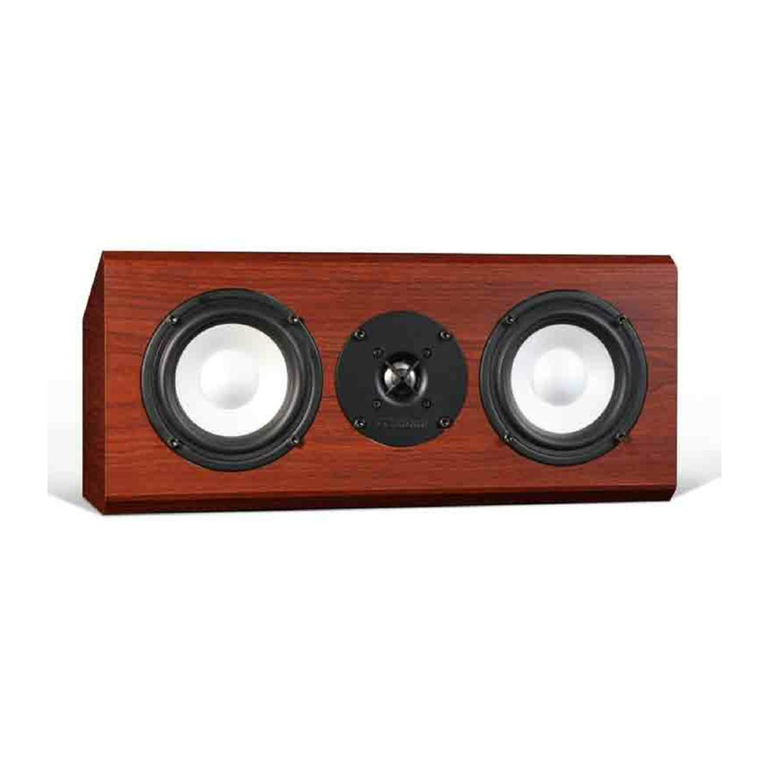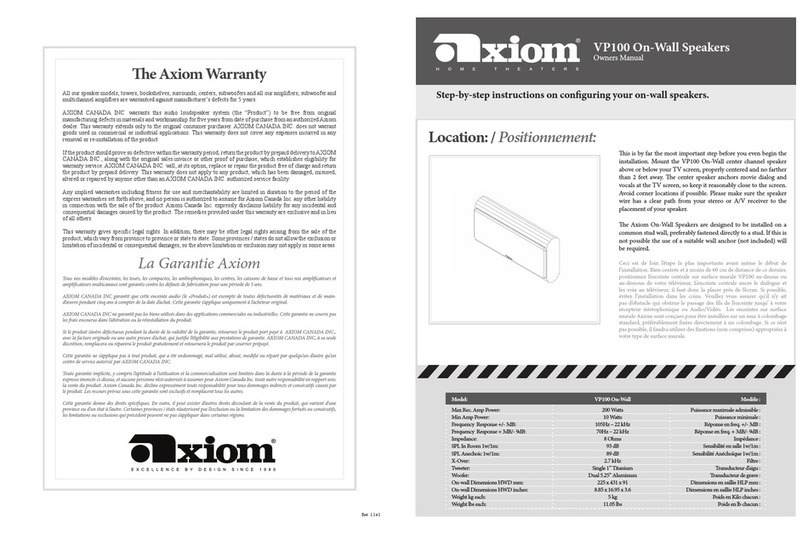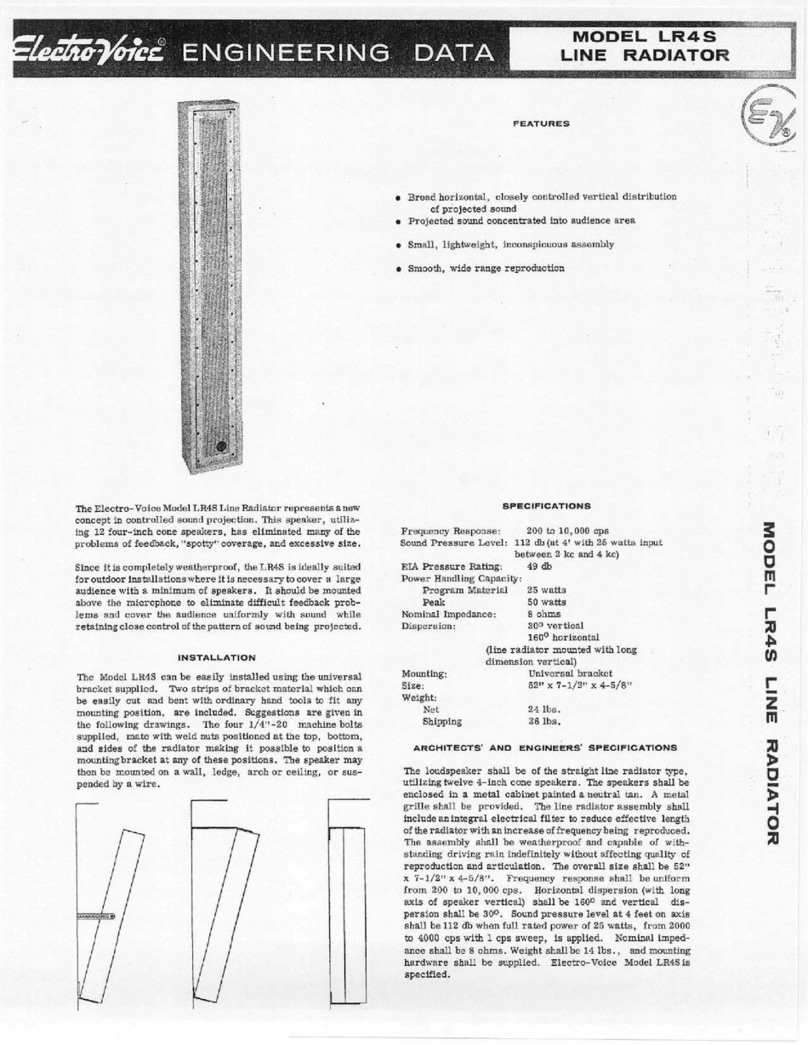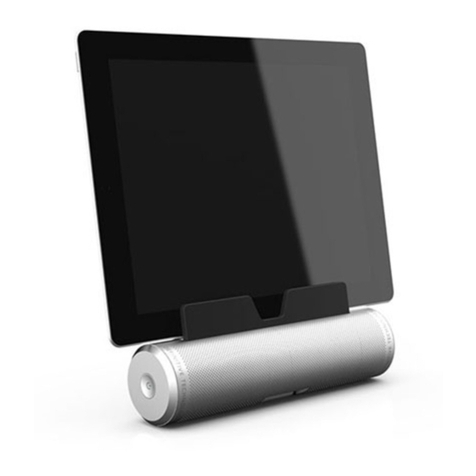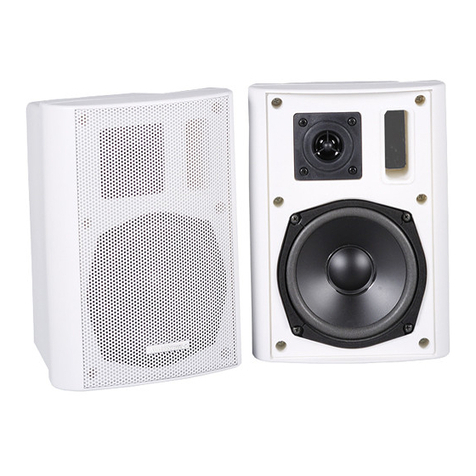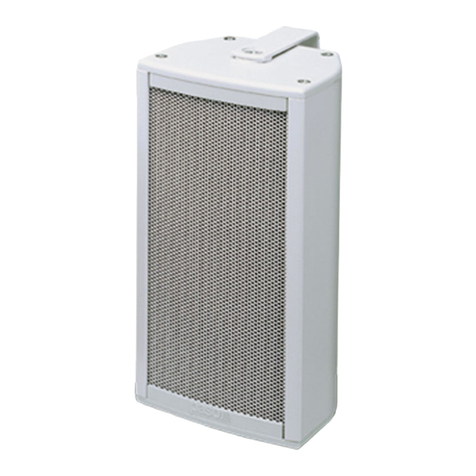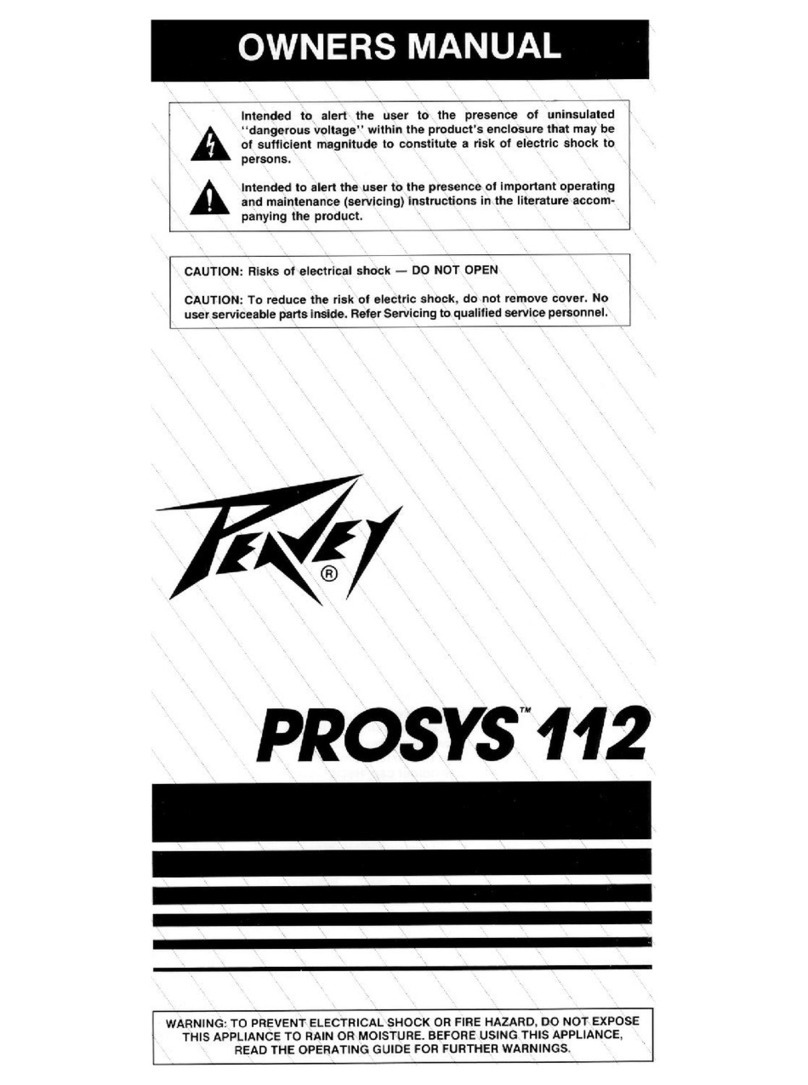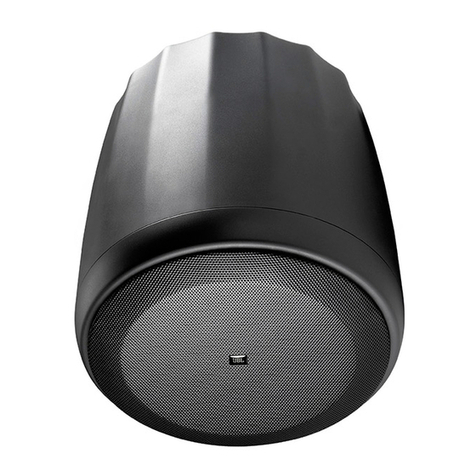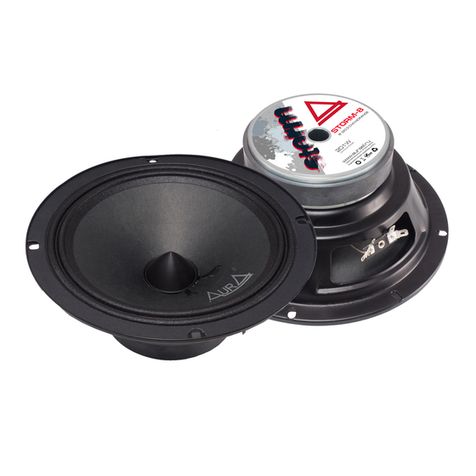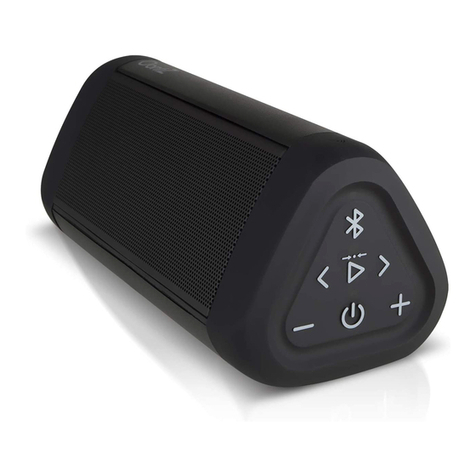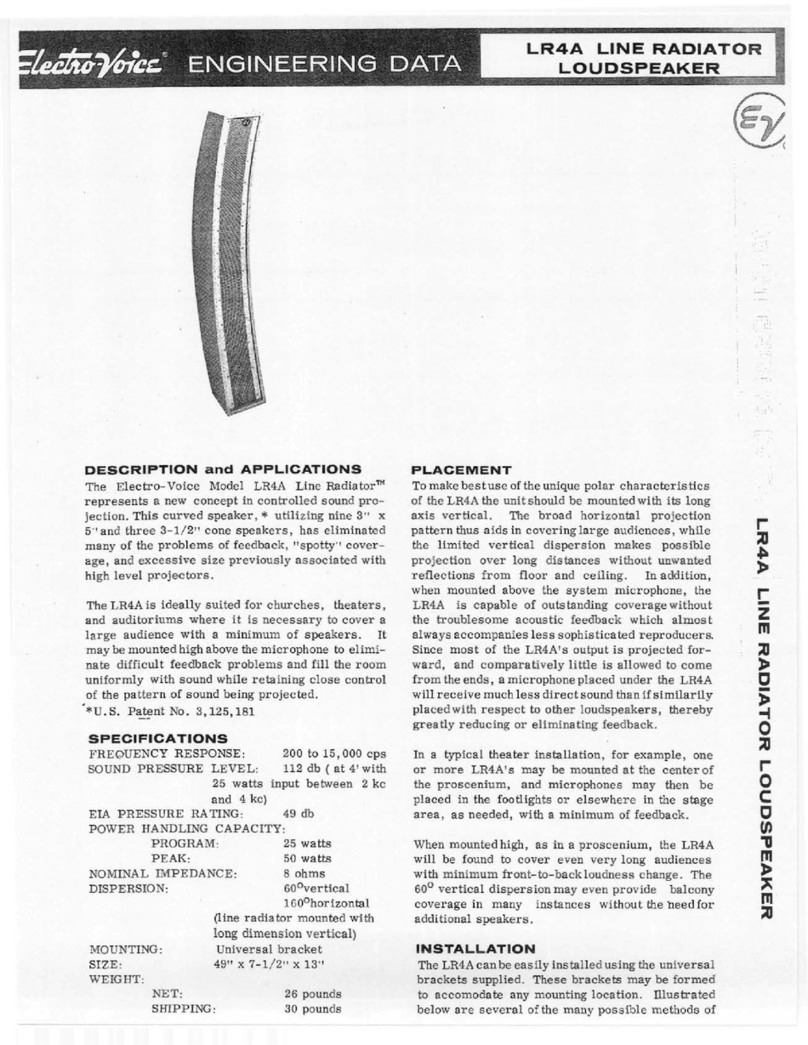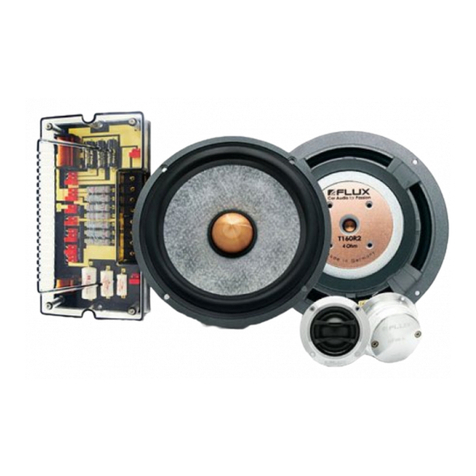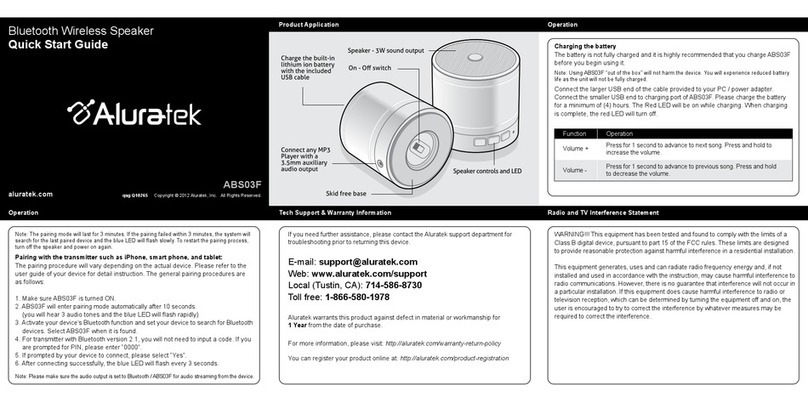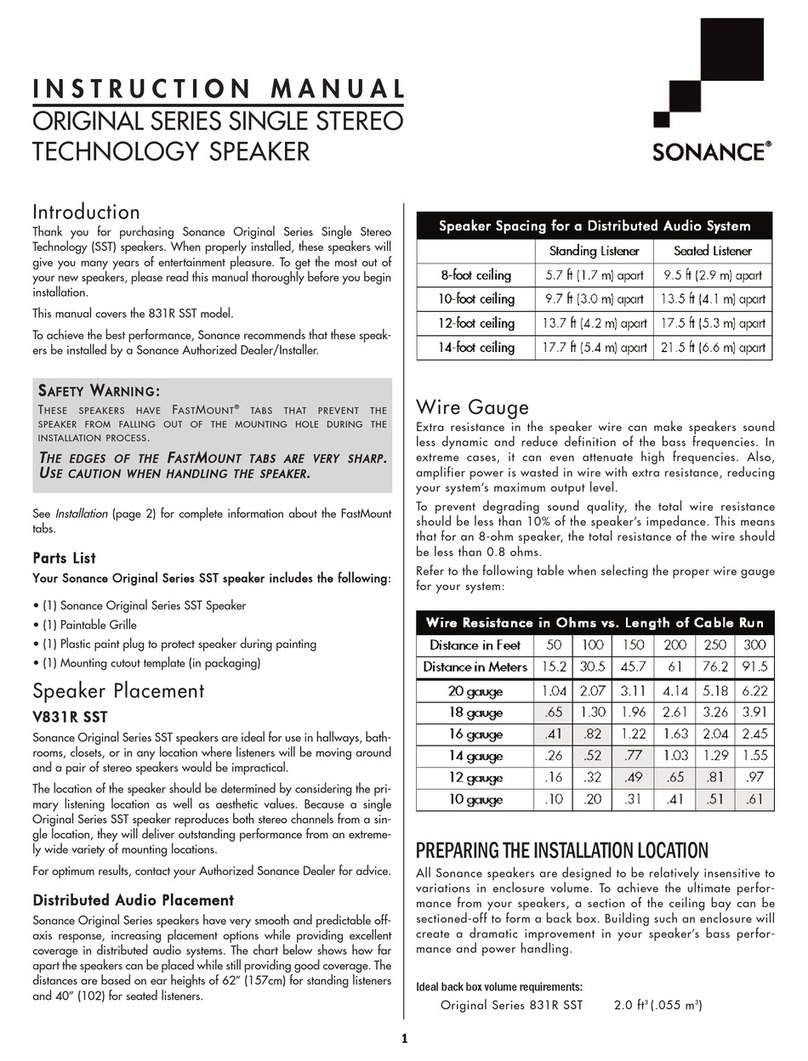Axiom Millennia M60 User manual

-
-
-
-
Amplifier 1
Amplificateur 1
Amplifier 2
Amplificateur 2
Right Front
Avant droit
Left Front
Avant gauche
Front / Avant
LR
LR
Front / Avant
4. Connections / 4. Branchement
BIWIRING: Remove the two gold bridging bars linking the two pairs of
binding posts for the separate woofer and midrange/tweeter sections of
the crossover for each speaker. Connect two speaker cables--one cable
to the upper pair of binding posts and one cable to the lower pair--for
each speaker (four cables for two speakers). At your receiver or amplier,
connect the two cables to one pair of red and black output terminals for the
le channel, and two speaker cables to the other pair of output terminals
for the right channel.
Always maintain the red-to-red (+ to +) and black-to-black (- to -)
connection scheme for each channel’s speaker connections.
BIAMPING: To power your speaker with two ampliers, remove the two
gold bridging bars linking the two pairs of binding posts for the separate
woofer and midrange/tweeter sections of the crossover for each speaker.
Connect one stereo amp to the lower set of binding posts on each speaker
(the woofers), and the second stereo amp to the upper pair of binding
posts (the mid range/tweeters) on each. Adjust the level (gain) of each amp
for equal output, unless you wish to change the spectral balance of each
speaker.
+++
BI-CÂBLAGE: Retirez les deux bandes de connexion parallèle dorées qui relient les
deux paires de bornes pour disjoindre les sections woofer et médiums/aigus du ltre
de chaque enceinte. Branchez deux câbles de haut-parleur - un câble à la paire de
bornes supérieure et un câble à la paire inférieure - de chaque enceinte (quatre câbles
pour deux enceintes). Branchez deux câbles à une paire de bornes de sortie rouge et
noire du canal gauche de l’ampli ou du récepteur, et deux câbles à la paire de bornes
de sortie du canal droit.
Respectez toujours la polarité rouge à rouge (+ à +) et noire à noire (- à -) lors du
branchement des enceintes de chaque canal.
BI-AMPLIFICATEURS: Pour alimenter vos enceintes à l’aide de deux amplicateurs
séparés, retirez les deux bandes de connexion parallèle dorées qui relient les deux
paires de bornes pour disjoindre les sections woofer et médiums/aigus du ltre de
fréquences de chaque enceinte. Connectez un ampli stéréophonique à la paire de
bornes inférieure de chaque enceinte (les woofers), et un deuxième ampli stéréo à la
paire de bornes supérieure de chaque enceinte (les tweeters). Ajustez le niveau (gain)
de chaque ampli pour obtenir une puissance de sortie égale, à moins que vous ne
vouliez modier l’équilibre spectral de chaque enceinte.
Step-by-step instructions on conguring your oorstanding speakers.
Instructions, étape par étape, pour la mise en fonction de vos enceintes colonnes.
1. e Speakers: / 1. Les Enceintes:
Turn the speakers around and look at the back panel. You’ll see a pair of 5-way
clear-plastic binding posts, to which you are going to connect the speaker
cables from your receiver or amplier.
Each gold binding post has a colored ring around it-- RED is POSITIVE,
BLACK is NEGATIVE. Most receiver and amplier manufacturers use this
color code and you should use it as well--it makes things a lot easier to hook
up your speaker cables.
You will also see a positive (+) sign engraved in the plastic beneath the RED
binding post, and a negative (-) sign beneath the BLACK post. Your amplier
may or may not have these positive and negative symbols. If you wish, you can
use these symbols along with the color coding to guide you.
+++
Examinez le panneau arrière des enceintes. Vous y trouverez une paire de bornes
“5 façons” plaquées or auxquelles vous devrez connecter les câbles de haut-parleur
provenant de votre récepteur ou amplicateur.
Chaque borne est dotée d’une bague de couleur - ROUGE est le POSITIF et NOIR est
le NÉGATIF. La plupart des fabricants de composantes électroniques utilisent ce code
couleur et vous devriez le respecter. Il simplie la connexion des câbles de haut-parleur.
Vous verrez également un symbole positif ( + ) gravé dans le plastique sous la borne
ROUGE et un symbole NÉGATIF ( - ) sous la borne NOIRE. Votre amplicateur n’est
pas nécessairement doté de ces symboles positifs et négatifs. Ils sont complémentaires
aux codes couleur et vous aideront à respecter la polarité de vos connexions.
Step-by-step instructions on conguring your oorstanding speakers.
Instructions, étape par étape, pour la mise en fonction de vos enceintes colonnes.
M60 & M80 Floorstanding Speakers
Owners Manual
The Axiom Warranty
All our speaker models; towers, bookshelves, surrounds,
centers, subwoofers and all our ampliers; subwoofer
and multichannel ampliers are warrantied against
manufacturer’s defects for 5 years.
AXIOM CANADA INC. warrants this audio loudspeaker
system (the “Product”) to be free from original manufacturing
defects in materials and workmanship for ve years from
date of purchase from an authorized Axiom dealer. This
warranty extends only to the original consumer purchaser.
AXIOM CANADA INC. does not warrant goods used in
commercial or industrial applications. This warranty does
not cover any expenses incurred in any removal or re-
installation of the product.
If the product should prove so defective within the warranty
period, return the product by prepaid delivery to AXIOM
CANADA INC., along with the original sales invoice or
other proof of purchase, which establishes eligibility for
warranty service.AXIOM CANADA INC. will, at its option,
replace or repair the product free of charge and return the
product by prepaid delivery. This warranty does not apply to
any product, which has been damaged, misused, altered or
repaired by anyone other than an AXIOM CANADA INC.
authorized service facility.
Any implied warranties including tness for use and
merchantability are limited in duration to the period of
the express warranties set forth above, and no person is
authorized to assume for Axiom Canada Inc. any other
liability in connection with the sale of the product. Axiom
Canada Inc. expressly disclaims liability for any incidental
and consequential damages caused by the product. The
remedies provided under this warranty are exclusive and in
lieu of all others.
This warranty gives specic legal rights. In addition, there
may be other legal rights arising from the sale of the product,
which vary from province to province or state to state. Some
provinces / states do not allow the exclusion or limitation of
incidental or consequential damages, so the above limitation
or exclusion may not apply in some areas.
Model: M60 M80 Modèle :
Enclosure: Acoustic Suspension Acoustic Suspension Clôture :
Max Amp Power: 250 Watts 400 Watts Puissance maximale admissible :
Min Amp Power: 10 Watts 10 Watts Puissance minimale :
Freq Resp +/-3dB (Hz): 37–22 kHz 34–22 kHz Réponse en freq. +/- 3dB :
Freq Resp +3dB- 9dB (Hz): 27–22 kHz 25–22 kHz Réponse en freq. + 3dB/- 9dB :
Impedance (Ohms): 8 Ohms 4 Ohms Impédance :
SPL in Room 1w/1m (dB): 93 dB 95 dB Sensibilité en salle 1w/1m :
SPL Anechoic 1w/1m (dB): 89 dB 91 dB Sensibilité Anéchoïque 1w/1m :
X-Over 200 Hz / 2 kHz 160 Hz / 2.3 kHz Filtre :
Tweeter: Single 1” Dual 1” Transducteur d’aigu :
Midrange: Single 5¼” Dual 5¼” Transducteur de médium :
Woofer: Dual 6.5” Dual 6.5” Transducteur de grave :
Dimens. H W D (inches): 37 ½” x 9 ¼” x 15” 39 ½” x 9 ¼” x 17” Dimensions HLP pouces :
Dimens. H W D (mm): 953 x 235 x 381 1003 x 235 x 432 Dimensions HLP mm:
Weight kg each: 21.591 kg 56.8 kg Poids en Kilo chacun :
Weight lbs each: 47.6 lbs 25.76 lbs Poids en lb chacun :

3. Le récepteur (ou l’amplicateur):
Examinez les bornes de sortie haut-parleur situées sur le panneau arrière de
votre récepteur ou amplicateur. À moins qu’il ne soit très ancien, les bornes
seront rouges et noires, comme celles de vos enceintes, ou du type à ressort,
également codées rouge et noir. Les très anciens amplis sont dotés de barrettes
à vis.
La borne ROUGE ( + ) de la sortie du canal droit de votre ampli doit être
reliée à la borne ROUGE ( + ) de l’enceinte droite. La borne NOIRE ( - ) de
la sortie du canal droit de votre ampli doit être reliée à la borne NOIRE ( - )
de l’enceinte droite. Répétez l’opération pour connecter les sorties du canal
gauche de votre ampli aux bornes de l’enceinte gauche, puis pour connecter les
enceintes ambiophoniques gauche et droite (à la gauche et à la droite de votre
position d’écoute), l’enceinte du canal central, et les enceintes additionnelles
arrière requises par les systèmes 6.1 ou 7.1.
Si votre récepteur ou amplicateur respecte le nouveau code de couleur de
C.E.A pour chaque canal, le terminal négatif (-) sera toujours noir, le terminal
positif sera de diérente couleur correspondant a chaque canal du système
ambiphonique.
Si vous êtes confus, notez la polarité positive (+) et la négative (-) pour chaque
haut-parleur. et le câble de chaque haut-parleur.
2. e Cables: / 2. Les Câbles:
Examine your speaker cables. On the ends, there may be spade lugs or
banana plugs, each one color-coded red or black like your speaker binding
posts to help you identify the red and black (positive and negative) wires
on each end of the cable. If the cable ends are bare wires and lack color
coding, check the wires: one may be copper-colored, the other silver. Some
generic cables may simply have a colored thread or a ribbed pattern on the
plastic insulation to indicate the positive wire. Alternatively, some speaker
cables, like Axiom’s, may have writing on one side or the other (perhaps the
brand name, for example) or even a positive sign or negative sign on each
of the conductors. Whichever you have, just follow the Red-To-Red, Black-
to-Black connection rule or use the + to + or - to - connection scheme for
each cable pair.
+++
Examinez vos câbles de haut-parleur. Il y aura peut-être à chaque extrémité
des cosses à fourche ou des ches banane. Chacune est codée rouge ou noir,
comme les bornes de vos enceintes, pour vous aider à déterminer le l positif et
le l négatif. Si les extrémités des ls sont dénudés, sans code couleur, examinez
bien les ls - l’un deux pourrait être de couleur cuivre, l’autre argent. Certains
câbles bon marché utilisent une gaine de plastique codée couleur ou striée
pour identier le l positif. Certains câbles, comme celui d’ Axiom, ont une
écriture inscrite sur un seul côté du l pour diérencier une polarité de l’autre.
Quelque soit les câbles que vous utilisez, connectez- les toujours en respectant
le code “rouge à rouge” et “noir à noir” (ou “+ à +” et “- à -”).
3. e Receiver (Amplier):
Look at the speaker connectors on the rear panel of your receiver or
amplier. Unless it’s very old, these will usually be red and black binding
posts, like those on your speakers, or red and black spring-loaded push
connectors. Vintage ampliers may have only screw terminals.
e Red (+) terminal on your receiver’s Right speaker output connects to
the Red (+) binding post of the Right speaker. e Black (-) terminal on
your receiver output connects to the Black (-) binding post on the Right
speaker. Follow the same pattern to connect the receiver’s Le speaker
outputs to the Le speaker’s binding posts, then the le surround (the
speaker to your le from your listening seat), and right surround speakers,
the center-channel speaker, and additional rear speaker(s) required by 6.1-
or 7.1-channel systems.
If your A/V receiver or amplier has the new Consumer Electronics
Association color coding (pictured below) for each speaker channel, the
negative terminal (-) will always be black, however, the positive terminal (+)
will have a dierent color corresponding to each channel of the surround
system.
If you nd this color coding confusing, note the positive (+) and negative
(-) polarity for each speaker and the speaker cable.
H.P avant gauche; blanc
H.P. caisson de grave; pourpre
( sortie RCA seulement )
H.P avant droit; rouge
H.P. avant central; vert
H.P. cote gauche; bleu
H.P. cote droit; gris
H.P. arrière gauche; brun
H.P. arrière droit; beige
Step 1 / Étape 1
Bare ends of speaker wire.
Extrémités dénudées des ls d’enceinte.
Step 2 / Étape 2
Leave washer down.
Laissez la rondelle vers le bas.
Step 3 / Étape 3
Insert bare end of wire through exposed hole
on binding post. Ensure postive wire from
Amp is in red connector.
Insérez l’extrémité dénudée du l à travers le
trou exposé sur la borne d’attache. Assurez-vous
que le l positif en provenance de l’amplicateur
est dans le connecteur rouge.
Step 4 / Étape 4
Tighten nuts with supplied plastic wrench.
Serrez les écrous avec la clé en plastique fournie.
Step 1 / Étape 1
Li washer.
Soulevez la rondelle.
Step 2 / Étape 2
Insert spade into slots in binding post. Ensure
positive wire from Amp is in red connector.
Insérer la cosse dans les fentes de la borne
d’attache. S’assurer que le l positif en
provenance de l’amplicateur est dans le
connecteur rouge.
Step 3 / Étape 3
Tighten nuts with supplied plastic wrench.
Serrez les écrous avec la clé en plastique fournie.
Step 1 / Étape 1
Tighten nuts with supplied plastic wrench
Serrez les écrous avec la clé en plastique fournie.
Step 2 / Étape 2
Ensure positive wire from Amp is in red connector.
Assurez-vous que le l positif en provenance de
l’amplicateur est dans le connecteur rouge.
Step 3 / Étape 3
Insert banana plug.
Insérez la che banane.
Bare Wire Spade Lug (1/4-inch Spade) Banana Plug (3/4-inch Spacing)
Fildénudé Cosse à Fourche (Cosse de 1/4-po) Fiche Banane (Espacement de 3/4-po)
Front Le speaker: White
Subwoofer: Purple
(line-level RCA output only)
Front Right: Red
Center: Green
Le Surround (side): Blue
Right Surround (side): Gray
Le Back Surround: Brown
Right Back Surround: Tan
Step-by-step instructions on conguring your oorstanding speakers.
Instructions, étape par étape, pour la mise en fonction de vos enceintes colonnes.
Plastic Wrench
La clé en plastique
This manual suits for next models
3
Other Axiom Speakers manuals

Axiom
Axiom FMS 16 Specification sheet
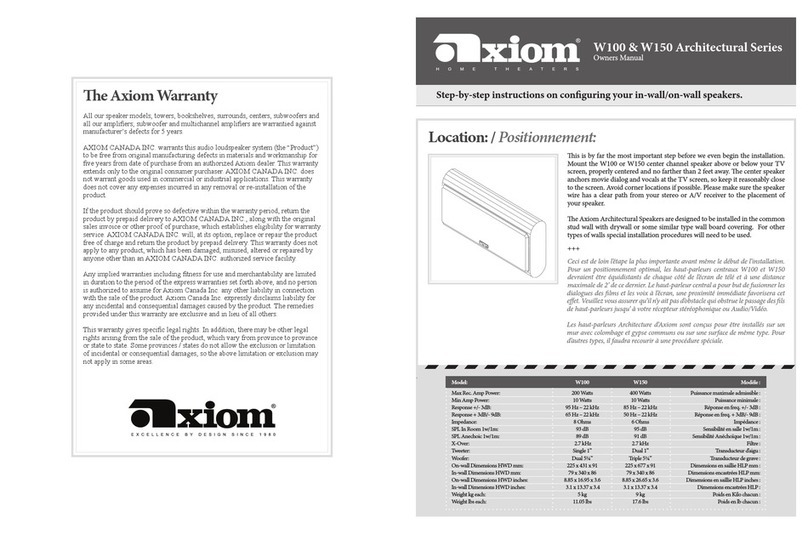
Axiom
Axiom Architectural W100 User manual

Axiom
Axiom ED150A User manual

Axiom
Axiom M22 v3 User manual
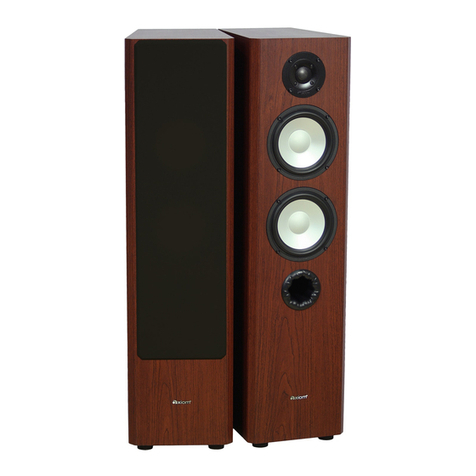
Axiom
Axiom MILLENNIA M50 Technical manual

Axiom
Axiom AX8000 NEO User manual
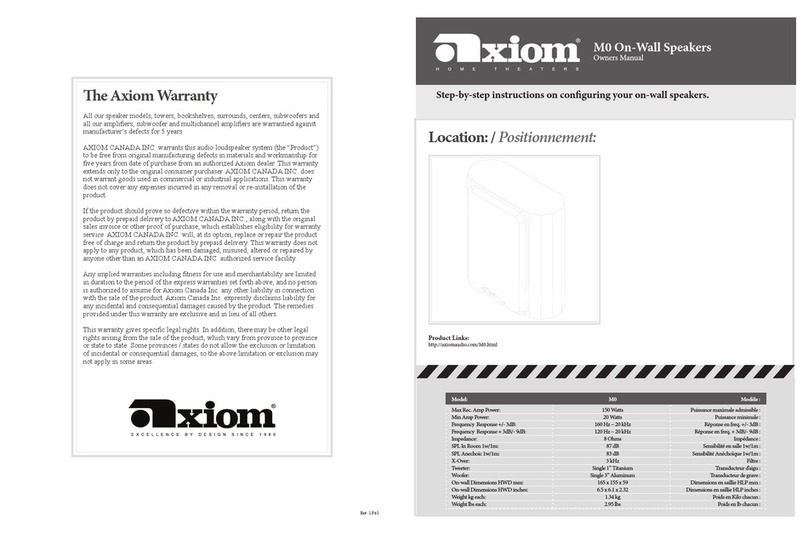
Axiom
Axiom M0 User manual
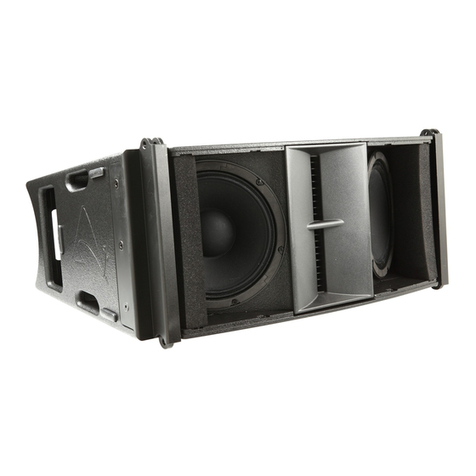
Axiom
Axiom AX2010P User manual
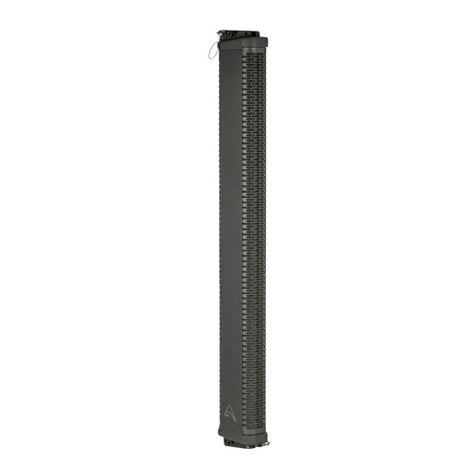
Axiom
Axiom AX16CL User manual
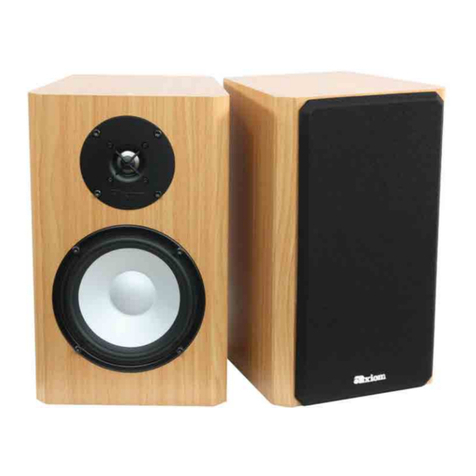
Axiom
Axiom M3 v3 User manual

Axiom
Axiom Millennia User manual
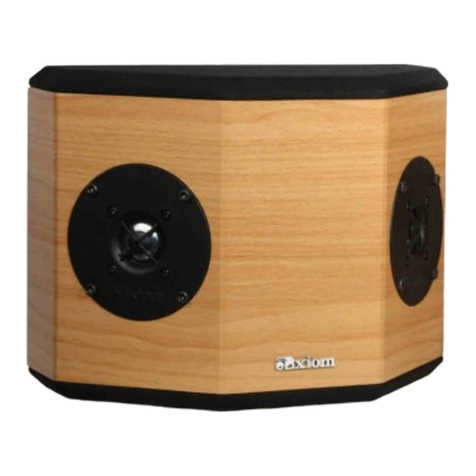
Axiom
Axiom QS8 v3 User manual
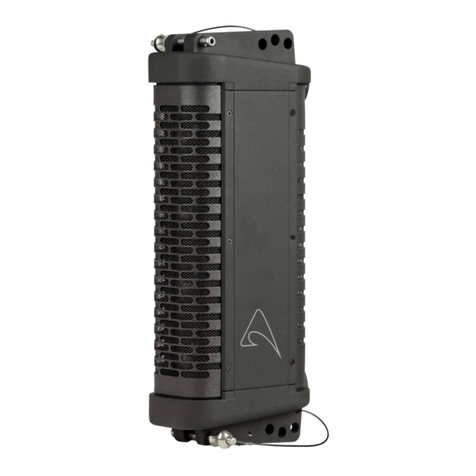
Axiom
Axiom AX4CL User manual

Axiom
Axiom T2 User manual
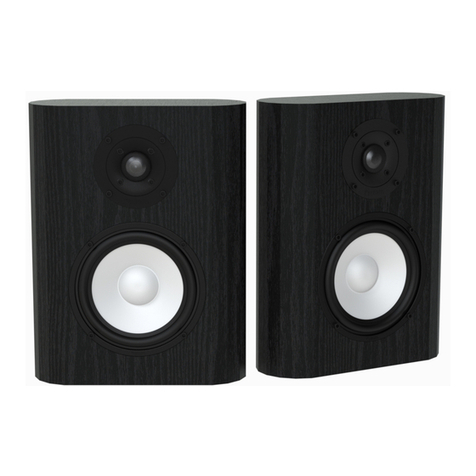
Axiom
Axiom M3 User manual

Axiom
Axiom LFR180 User manual
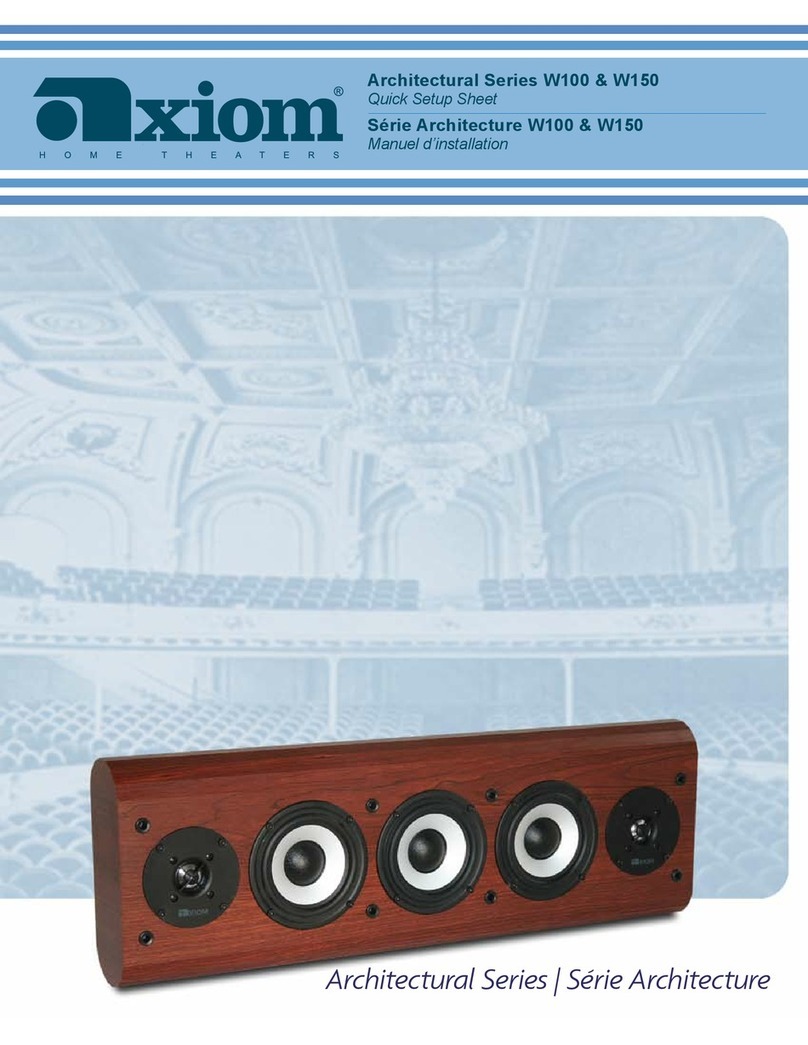
Axiom
Axiom Architectural Series W100 Specification sheet
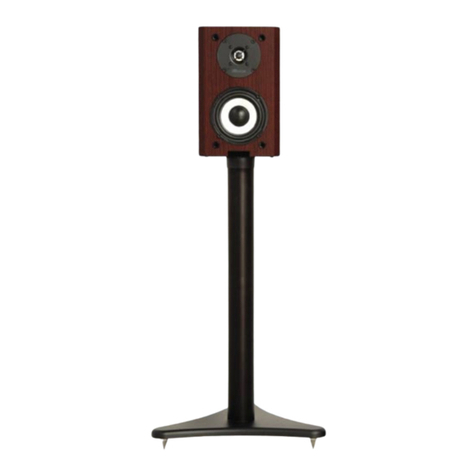
Axiom
Axiom FMS 16/24 Specification sheet
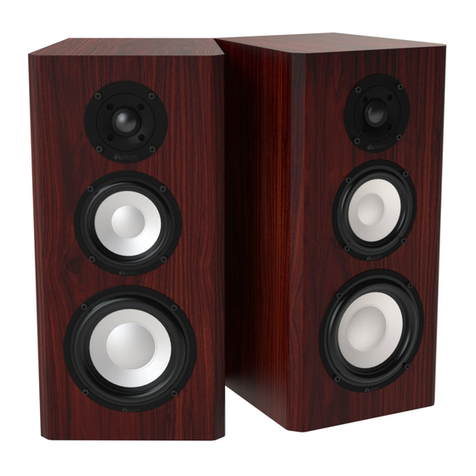
Axiom
Axiom M5HP v4 User manual

Axiom
Axiom Architectural W2 User manual

